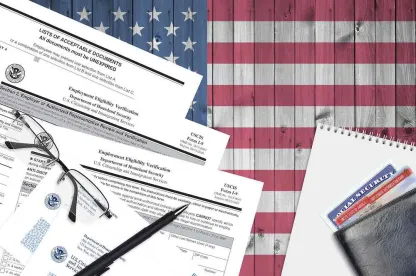Highlights
The start of the government fiscal year leads to a major advancement in the Visa Bulletin for employment-based applicants, especially for Chinese and Indian nationals
USCIS fee increase is effective Oct. 2, 2020, for certain types of nonimmigrant and naturalization petitions
USCIS has changed the premium processing service timeframe from 15 calendar days to 15 business days without increasing the cost
On Sept. 24, 2020, the U.S. Department of State (DOS) released the October 2020 Visa Bulletin which indicates when immigrant visa applicants are eligible to file applications for adjustment of status with U.S. Citizenship and Immigration Services (USCIS). The DOS issues a Visa Bulletin each month with cut-off dates based upon an applicant’s employment-based preference category and country of chargeability. Congress caps the number of green cards that may be issued each year. As a result, the number of immigrant visa applicants seeking to adjust status or, in other words, receive a green card, has exceeded the cap thus consistently creating a backlog, especially for Chinese and Indian nationals.
Oct. 1 marks the beginning of the new fiscal year for USCIS and as expected, the number of available employment-based visas has increased due to a significant drop in processing capacity attributed to COVID-19 related closures at consular posts and within USCIS service centers.
As a result, USCIS has stated on its website that applicants may use the “Dates for Filing” chart in the Bulletin when determining eligibility thus significantly advancing the filing eligibility for employment-based applicants in several categories, including for nationals of China and India.
Dates for Filing
| Employment-based |
All Chargeability
|
China - Mainland Born |
El Salvador
|
India | Mexico | Philippines |
| 1st | C | 01SEP20 *+2y |
C |
01SEP20
|
C | C |
| 2nd | C |
01OCT16 |
C | 15MAY11 *+1y,9m |
C | C |
| 3rd | C | 01JUN18 *+1y |
C | 01JAN15 *+4y,11m |
C | C |
| Other Workers | C | 01OCT08 | C | 01JAN15 | C | C |
| 4th | C | C | 01FEB18 | C | C | C |
| Certain Religious Workers | C | C | 01FEB18 | C | C | C |
| 5th Non-Regional Center (C5 and T5) |
C | 15DEC15 | C | C | C | C |
| 5th Regional Center (I5 and R5) |
C | 15DEC15 | C | C | C | C |
*Indicates advancement period.
Unlike prior months, the EB-3 preference category for China and India has advanced more rapidly than for the EB-2 preference category. This means that individuals and their employers could “downgrade” an applicant’s I-140, Immigrant Petition for Alien Worker from EB-2 to EB-3 in order to become eligible to concurrently file an application for adjustment of status with USCIS.
Increased Filing Fees
The October 2020 Visa Bulletin also coincides with an increase in filing fees for some of the most common type of filings, including nonimmigrant and adjustment of status and nonimmigrant (H, L, TN, O-1, etc.) petitions.
On Aug. 3, 2020, the Department of Homeland Security (DHS) issued a final rule* that increases filing fees effective October 2, 2020 for certain immigration and naturalization petitions filed with USCIS. Of notable significance, the filing fee for nonimmigrant visa petitions will vary depending on the visa classification being requested (e.g. H, L, O, TN, etc.). USCIS has also announced that it will be releasing new I-129 forms for each of these different visa types. The overall cost for adjustment of status (Form I-485) petitions will also significantly increase. USCIS will no longer bundle the fee of Form I-485 with Form I-765 (Employment Authorization Document) and Form I-131 (Advance Parole/Travel Document). Applicants will be required to pay a separate fee for each of the three applications, which will total $2,270. The bundled fee was previously $1,140 for all three applications.
Filing fees are as noted:
| Immigration Benefit Request | Current Fee | Final Fee | Change ($) | Percent Change |
| I-90, Application to Replace Permanent Resident Card | $455 | $415 | ($40) | -9 percent |
| I-129 (TN, E and other classifications) | $460 | $695 | $235 | 51 percent |
| I-129 (H-1B) | $460 | $555 | $95 | 21 percent |
| I-129 (L-1) | $460 | $805 | $345 | 75 percent |
| I-129 (O-1, O-2) | $460 | $705 | $245 | 53 percent |
| I-130 Petition for Alien Relative | $535 | $560 | $25 | 5 percent |
| I-131 Application for Travel Document | $575 | $590 | $15 | 3 percent |
| I-140 Immigrant Petition for Alien Worker | $700 | $555 | ($145) | -21 percent |
| I-485 Application for Adjustment of Status | $1,140 | $1,130 | ($10) | -1 percent |
| I-539 Application to Extend/Change Nonimmigrant Status | $370 | $400 | $30 | 8 percent |
| I-612 Application for Waiver of Foreign Residence Requirement | $930 | $515 | ($415) | -45 percent |
| I-751 Petition to Remove Conditions on Residence | $595 | $760 | $165 | 28 percent |
| I-765 Application for Employment Authorization | $410 | $550 | $140 | 34 percent |
| N-400 Application for Naturalization | $640 | $1,170 | $530 | 83 percent |
| Biometric Fee | $85 | $30 | -$55 | -65 percent |
* To access the full list of fee changes, please see the Final Rule, starting on page 13.
USCIS also changed the premium processing timeframe from 15 calendar days to 15 business days. The premium processing filing fee remains at $1,440 as set on Oct. 31, 2019.







 />i
/>i

